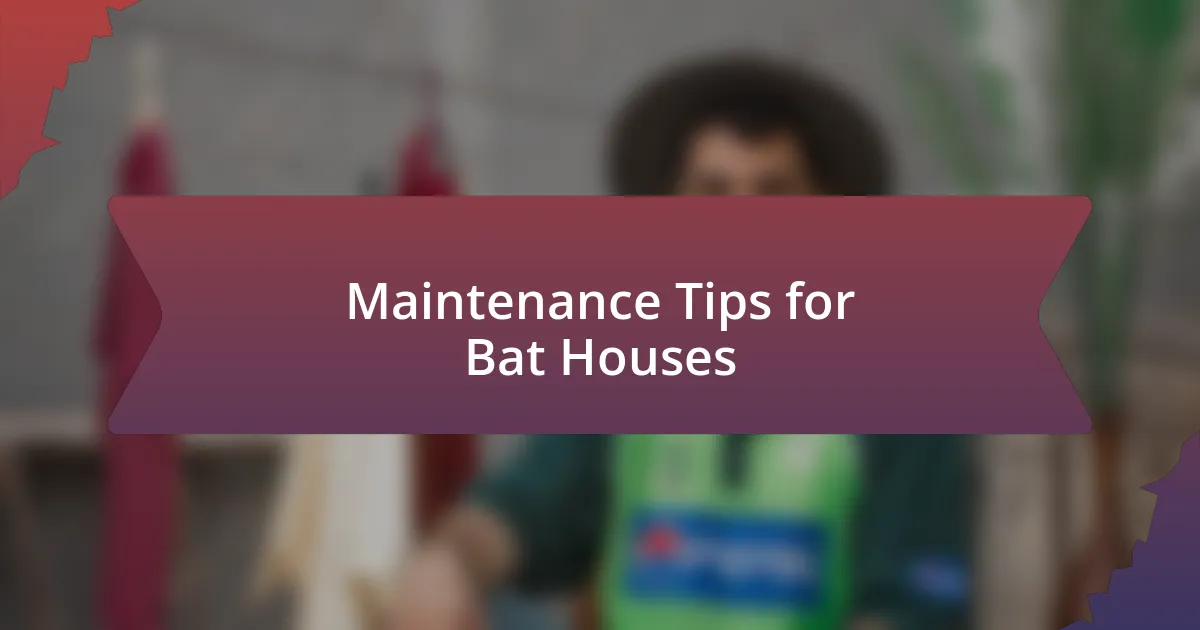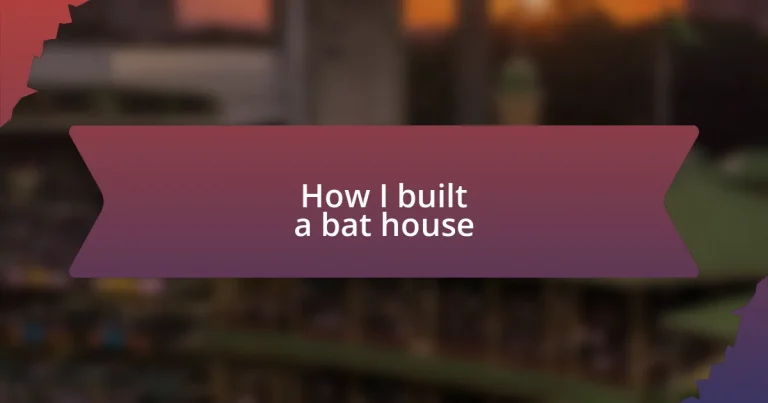Key takeaways:
- Choose a sunny, elevated location for the bat house to protect from predators and ensure warmth.
- Use untreated wood and other natural materials for construction to create a safe and inviting environment for bats.
- Regular maintenance, such as cleaning and inspection, is vital to keep the bat house functional and welcoming over time.
- Incorporate nearby water sources and native plants to attract bats and enhance their habitat.

Choosing the Right Location
When I was choosing the location for my bat house, I quickly realized how crucial it was to find a sunny spot. Bats love warmth, so placing the house in an area that gets at least six hours of direct sunlight each day made all the difference. Have you ever noticed how creatures tend to gravitate toward warmth? It’s fascinating!
Another consideration was the height. I positioned my bat house about 10 to 15 feet off the ground, which not only protects the bats from predators but also keeps them away from human activity. It made me feel like I was creating a safe haven, almost like building a little condo in the trees just for them. Doesn’t it feel rewarding to create a space where wildlife can thrive?
I also found that proximity to water sources, like a pond or stream, significantly increased the chances of bats moving in. In my backyard, I have a small pond, and I was amazed at how it acted like a magnet for these nocturnal creatures. Have you ever thought about how vital it is for wildlife to have easy access to water? It’s something that I now prioritize in my outdoor planning.

Selecting Materials for Construction
Selecting Materials for Construction
When I dove into building my bat house, I realized the materials I chose could make or break the success of my project. I found that untreated wood was the best option, as it’s durable yet safe for bats. It was satisfying to envision how natural materials would blend seamlessly into the environment, creating a welcoming feel for these essential pollinators and insect controllers.
Here are some key materials I decided on for my bat house construction:
– Untreated wood: Avoiding chemicals ensures safety.
– Exterior latex paint: This adds a protective layer while reflecting heat.
– Mesh hardware cloth: I used it for ventilation, allowing bats to choose their preferred temperature.
– Wood screws: For a sturdy and secure assembly that withstands the elements.
Choosing the right materials really added to the overall integrity of the bat house and helped me connect more deeply with the environment around me. Each choice felt like an opportunity to create something meaningful and beneficial for both myself and the bats.

Tools Needed for Building
When I set out to gather tools for building my bat house, I found that having the right equipment was crucial. A simple saw made quick work of cutting the wood, while a measuring tape ensured precise dimensions. These seemingly ordinary tools became essential companions in my creative process, transforming raw materials into a sanctuary for bats.
Nailing pieces together required a reliable hammer and some sturdy wood screws, which I learned quickly were much easier than trying to use nails alone. The first time I drove a screw in, I felt a thrill; it was a tangible sign of progress. I still remember the satisfaction of seeing each component come together, reinforcing my connection to the project and to nature itself.
For those looking to embark on this adventure, a checklist helps ensure you don’t miss anything. Here’s a simple comparison of tools versus their alternative options which I discovered along the way:
| Tool | Alternative |
|---|---|
| Saw | Hand saw |
| Measuring tape | Yardstick |
| Drill | Manual screwdriver |
| Hammer | Wood glue |

Step by Step Construction Guide
Once I had my tools ready, it was time to start on the foundation of the bat house. I began by cutting the wood into precise pieces, ensuring each panel was uniform. There’s something incredibly satisfying about the process; each cut felt like taking a step closer to creating a habitat that would welcome these fascinating creatures.
Next, I arranged the panels to form the structure’s basic shape. As I fastened the sides together, I pondered how important each screw was in holding not just the wood, but the entire purpose of the bat house. With every twist of the drill, I imagined the bats finding safety within its walls, and that thought motivated me significantly.
Finally, I moved on to adding ventilation holes and landing pads, which are critical for the bats. I remember feeling a sense of responsibility; these adjustments weren’t just about aesthetics. They reflected my commitment to providing a genuine home. This thoughtful attention to detail is what transformed the bat house from a simple project into an inviting sanctuary for wildlife.

Best Practices for Bat Houses
When it comes to bat houses, placement is everything. I once placed a bat house too close to an overly bright streetlight, thinking it would be a cozy spot for the bats. However, I quickly learned that bats prefer darker areas, away from artificial light, where they can thrive undisturbed. Finding the right location, ideally at least 15 feet off the ground and facing south or southeast, can significantly increase the chances of bats taking up residence.
I always emphasize the importance of the material used for constructing bat houses. Pressure-treated wood may seem like a good choice for durability, but I discovered that untreated cedar or plywood works best. It’s more inviting for bats, allowing them to easily cling to the walls. Plus, a natural finish keeps the wood cooler in the summertime, making it a comfortable haven for these creatures, which is crucial for their survival.
Regular maintenance can’t be overlooked either. I remember my initial excitement faded when I found my bat house deteriorating after a few years. Cleaning it out during the fall, when bats migrate, and checking for any repairs needed keep it in top shape. After all, ensuring a welcoming environment is key to encouraging bats to return year after year. What’s the point of all that work if I can’t provide a lasting home?

Maintenance Tips for Bat Houses
Bat houses need a little love to stay functional. After my first winter with a bat house, I noticed some peeling on the roof; a simple coat of non-toxic wood sealant was all it took to protect it. It’s a small task, but that extra care made me feel more connected to the bats that relied on my efforts.
I learned to check the interior regularly for guano (bat droppings), which is actually a good sign! Spotting that evidence means the bats are using the house, but I also have to be mindful of any buildup. Cleaning it out gently ensures a clean living space for new occupants while keeping the existing ones happy.
Seasons change, and so should our upkeep. As summer approaches, I always inspect for overhanging branches that might create undesirable conditions or attract predators. By ensuring the area around the bat house is clear, I not only safeguard the bats but also foster a sense of responsibility for their well-being that I find incredibly rewarding.

Encouraging Bats to Roost
When I first installed my bat house, I wanted to make it feel inviting for these fascinating creatures. I learned that bats are attracted to roosts that mimic their natural habitats, so I strategically placed my house in a sunny spot, allowing it to warm up during the day. Have you ever wondered how sunlight can influence bat behavior? I found that the right exposure helped make my house a preferred choice when the evening came.
I also discovered that adding some nearby water sources, like a small pond or birdbath, can be a game-changer. Bats are more likely to roost where they can find food and hydration easily. The first night I noticed bats swooping down to drink, my heart raced with joy; it was proof that my efforts were starting to pay off!
Another tip that worked wonders for me was creating a welcoming atmosphere around the bat house. I avoided using chemicals in my yard that might be harmful to them and planted native flowers that attract insects. Seeing bats thriving nearby has not only changed the atmosphere of my garden but has deepened my appreciation for these vital pollinators. It’s amazing how small changes can lead to such big rewards!



